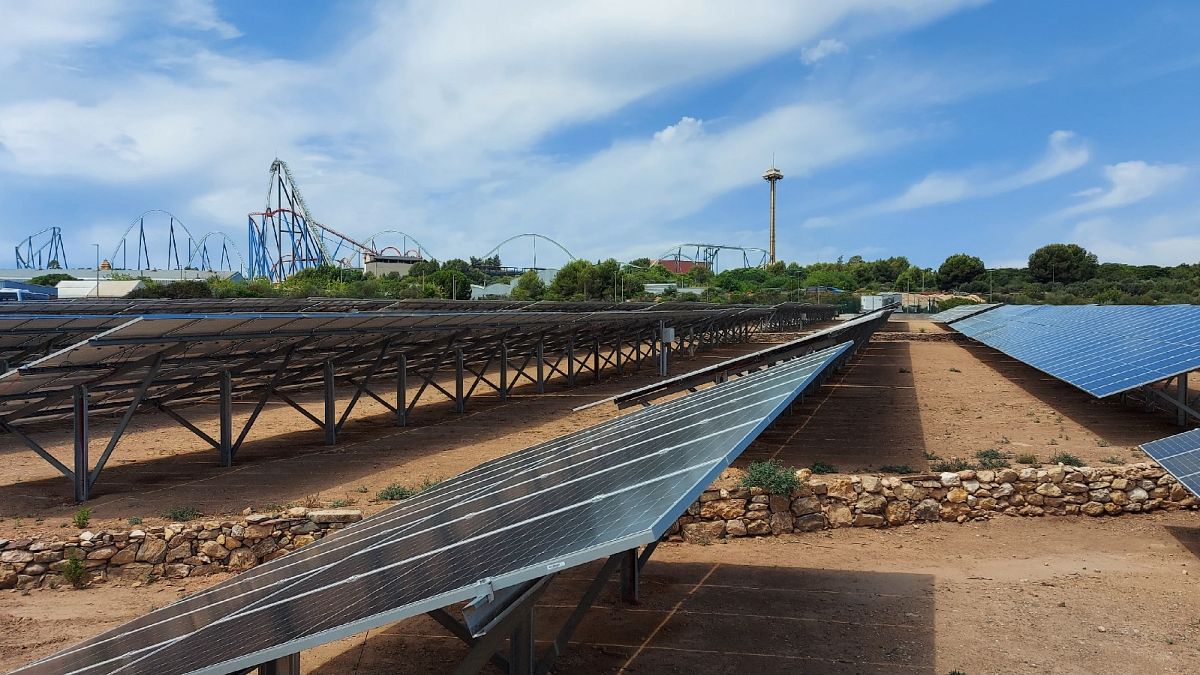Spain's tourism companies are increasingly turning to renewables to power themselves and prove that the sector can also be a force for good.
Unbeknown to the tourists hurtling around the rollercoasters under the beating July sun, a silent sea of black solar panels has made a subtle change to one of Europe’s biggest attraction parks.
Some 11,000 panels will now provide a third of the energy to power the rides like Ferrari Land at PortAventura World after the solar park went live earlier this month.
The panels dominate a huge field that was used for growing crops but will now help make this resort, which attracts thrill seekers from across Europe, a reference point for a new kind of sustainable tourism.
Héctor Gómez, Spain’s minister for industry, commerce and tourism, said last month Spain was the best European country for investments in renewable energy whether they are in tourism or cars like Tesla.
“What we say to the big companies interested in Spain is that we are the most competitive country in terms of price of renewable energy,” he then told La Vanguardia, a Spanish newspaper.
At Portaventura World, the solar park fills enough space for nine football fields and provides the same amount of electricity used in 3,000 family homes during a year.
This is just the first phase of an ambitious plan by the pleasure park and Spanish energy giants Endesa to make the switch to green tourism.
The park, which is about 110 km south of Barcelona, attracted 5.1 million tourists last year, with Spaniards, French and British the biggest groups by nationality.
Tourism can also 'work for the planet'
Other attraction parks in Europe and beyond have consulted PortAventura World about the project as the link between having fun and reducing our carbon footprints becomes compelling.
The solar project at PortAventura World will save 4,000 tonnes of CO2 per year.
A second phase of panels is planned later this year and the park has also installed 150 electric car chargers which are free for customers and staff.
Just how important this switch to green tourism is was made clear when executives arrived late for the panels’ inauguration earlier this month because of a downpour in Zaragoza, on the route between Madrid and the park.
Cars with their drivers clinging desperately to the roofs were swept down roads which were reduced to rivers in images that went viral around the world.
With some understatement, José Bogas, the CEO of energy company Endesa, admitted “climatic conditions” delayed executives' arrival.
Standing in front of banks of solar panels, Choni Fernández, sustainability director of Portaventura World, said: “We don’t just want to inaugurate the solar panels but also the electric charger hubs in our transition towards a more sustainable form of tourism.
“We want to emphasise how tourism is not a source of richness and creation of jobs but also how we can work for the planet.”
She added: “In September we will start an educational section to show school visitors how you generate renewable energy. It can be a place to teach the youngest among us about the challenges we face.”
Wineries and hotels join the movement
But in tourism-dependent Spain, where the sector accounts for about 12% of gross domestic product, green energy is being deployed across the sector.
For those with a taste for wine, bodegas in the northern Castile and Leon region are using renewable power to make the Ribera del Duero, a rich red and white which is increasingly rivalling Rioja, Spain's most popular wine.
On the so-called ‘Golden Mile’, where there are a series of wineries, lies the Abadia Retuerta bodega.
“We contribute to the circular economy and a fundamental part of this is managing natural resources. A clear example of this is the use of solar panels from which we get about 30% of the power needed to run (the winery),” Enrique Valero, CEO of Abadia Retuerta, told Euronews.
“We want to do this in an ethical and responsible way.”
The huge winery, which also doubles as a luxury spa and hotel, produces wines at the top end of the market.
In another project, RIU Hotels and Resorts, a major Spanish hotel chain, signed a deal last year with Iberdrola to use renewable energy to provide 100% of the energy for 11,000 rooms in 27 hotels.
This will avoid the emission of 30,000 tonnes of CO2 – or the same amount which would be captured by about 300,000 trees.
Down the road from Portaventura World is Salou, a resort on the Costa Dorada which is popular with French and British tourists.
Here, private campsites have been fitted with solar panels on top of shades above parking places to generate power.
Salou Council, like many local authorities across Spain, wants to use renewable energy as part of its urban planning.
Pere Granados, mayor of Salou, said among projects planned will be the "renewal of urban lighting with renewable energy and energy efficiency systems".
So from big to small-scale projects, Spain is thinking of green tourism for the future.
